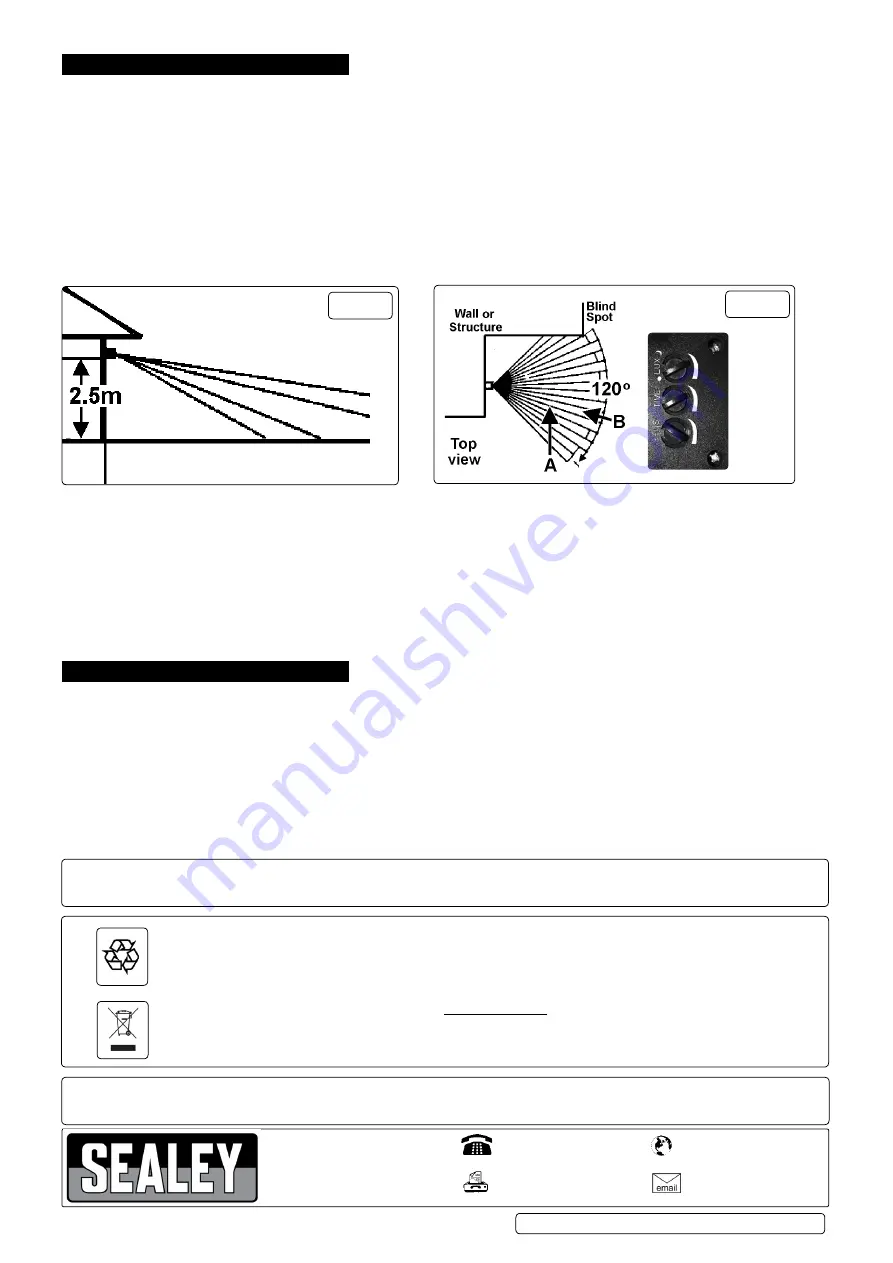
4. assembly
warning!
do not
connect unit to the mains power supply before installation.
4.1.
installation
4.1.1.
Give careful consideration to the position of unit to ensure you obtain maximum benefit from the lighting range, and that an
appropriate electrical power source can be provided.
4.1.2.
An approximate appropriate mounting height from the ground is 2.5m. (fig.1)
4.1.3.
This SMD LED floodlight develops minimal heat and is not subject to the same mounting restrictions that apply to halogen lamps
that become too hot to touch. We do however recommend that the floodlight should not be placed in cramped or restrictive
positions and should be fixed at the following minimum distances between the light and any surface/object.
● 500mm minimum between the top of the light and any overhead surface, or objects, i.e. ceilings, overhangs.
● 200mm between sides of light, walls, or objects.
● 2 metres minimum between the front of the light and any object to be illuminated.
Fix the light to a vertical surface with appropriate fixings.
ensure the lamp is connected to the mains by a qualified electrician.
4.2.
sensor
The sensor may be angled independently of the light. Mounted at approximately 2.5m above the ground the sensor will have approx
12m range (fig.1) with a 120º spread (fig.2)
4.2.1.
The sensor range can be reduced or optically adapted to local conditions by adjusting the sensor angle accordingly.
4.2.2.
Further adjustment may be made by tuning the three switches located on the underside of the sensor as follows: (fig.2).
switch 1. sensitivity. the sensor range will vary with temperature and factors such as passing cars, shade from large trees etc.
During cold weather the sensor range will be greater than when hot in summer temperatures. For example during hot weather the
forward detection range could fall from 12 to 6m and as such the sensor should be checked and adjusted. Note: the sensitivity factor is
far greater when an object passes across the detection area (fig.2A) than when an object approaches towards the detector (B).
Switch 2. Time adjuster: To adjust the amount of time the light will stay on when activated.
Switch 3. (Lux) Daylight adjustment: To adjust the sensor to come on in accordance with the diminishing daylight.
5. maintenance
5.1.
Clean the casing externally
(not the glass)
with a moist cloth.
8
do not
use solvents or abrasives to clean the light.
5.2.
Avoid touching the glass shield as handling may reduce its serviceable life and cause the glass to crack. if necessary clean the
glass shield with alcohol and a soft cloth. undo the single screw without removing it to clean internally.
8
do not
use the light without the glass shield.
8
do not
use the light without the weather seals intact.
NOTE:
It is our policy to continually improve products and as such we reserve the right to alter data, specifications and component parts without prior notice.
imPortant:
no liability is accepted for incorrect use of this product.
warranty:
guarantee is 12 months from purchase date, proof of which will be required for any claim.
sole uK distributor, sealey group.
Kempson way, suffolk Business Park,
Bury st. edmunds, suffolk.
iP32 7Ar
www.sealey.co.uk
sales@sealey.co.uk
01284 757500
01284 703534
web
led086/led087/led088/led089 | issue 1 26/05/16
Original Language Version
© Jack sealey limited
fig.1
fig.2
Parts support is available for this product. to obtain a parts listing and/or diagram,
please log on to www.sealey.co.uk, email sales@sealey.co.uk or telephone 01284 757500.
environmental Protection
recycle unwanted materials instead of disposing of them as waste. All tools, accessories and packaging should be
sorted, taken to a recycling centre and disposed of in a manner which is compatible with the environment.
when the product becomes completely unserviceable and requires disposal, drain off any fluids (if applicable)
into approved containers and dispose of the product and the fluids according to local regulations.
weee regulations
dispose of this product at the end of its working life in compliance with the eu directive on
waste electrical and electronic equipment (weee). when the product is no longer required, it must be disposed
of in an environmentally protective way. contact your local solid waste authority for recycling information.




















